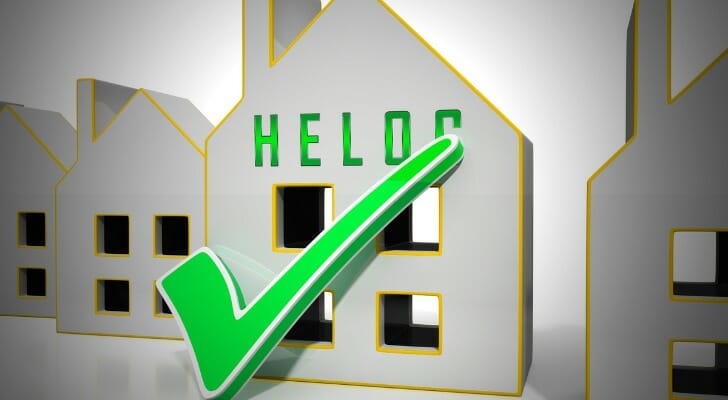With home values on the rise, many homeowners are tempted to access their equity for low-cost borrowing. Instead of refinancing or selling your home, you can use a home equity line of credit (HELOC) to borrow money as you need it. Before pursuing this form of financing, it’s important to understand the closing costs of HELOCs. There are also some factors to consider around whether a HELOC is really your best option. You can also work with a financial advisor as you consider how to get the most out of your home’s equity.
What Is a HELOC?
A home equity line of credit, or HELOC, is secured by your home. This means that if you default on payments, the lender could foreclose and take your home away.
HELOC credit limits vary based on the bank’s policies, the value of your home and how much you owe on your primary mortgage. Additionally, the bank will underwrite your application to determine a maximum credit limit based on your income, debt payments and credit score. Banks often have a maximum HELOC credit limit and a maximum loan-to-value for the combined amount of your mortgage and HELOC.
For example, let’s say that your home is worth $400,000 and you have a $250,000 mortgage. The bank allows up to a 90% loan-to-value ratio, which means that your maximum HELOC is $110,000.
Generally, HELOCs have a 10-year period where you can draw down the line before it turns into an amortizing loan. During the draw period, you can access your equity and pay down the HELOC repeatedly, as long as you don’t exceed your credit limit. Each month, you’ll pay interest based on the average daily balance of your HELOC. Once the draw period is over, the remaining balance is converted into a term loan that is paid over time (typically 20 years).
Why Get a HELOC?
There are many reasons why a homeowner may want to take out a HELOC on their home. Here are a few of the most common uses of a HELOC:
- Low-cost: Taking out a HELOC is generally lower-cost than refinancing your home. Since it is secured by your home, the interest is usually much less than a credit card or unsecured line of credit.
- Interest-only payments: During the draw period, borrowers usually only have to make interest-only payments based on the amount they’ve borrowed.
- Flexibility: The money can be used to pay off high-interest-rate debt, purchase investments, make home improvements, start a business or buy more properties. As you repay the balance, you can reuse that line of credit multiple times.
- No refinance is necessary: HELOCs allow you to tap into your home’s equity without refinancing your first mortgage. Many homeowners have locked in low interest rates and are hesitant about losing their current rate. This is especially true if the need to borrow is more short-term.
What Are the Closing Costs for a HELOC?
There are many fees to close a HELOC deal. An application fee is the fee charged when submitting an application for a loan. The average application fee ranges from $0 to $500. Then there are loan origination fees, which are charged when your HELOC is approved and funded. If your application is denied, you will not be charged this fee. Loan origination fees may be a flat rate or a percentage of your line of credit amount.
The lender often passes along the costs of obtaining your credit reports to underwrite your application. These fees range from $17 to $75 per applicant, so if you apply with your spouse, each of you will pay this fee. Also, there are processing or underwriter fees, which cover the cost of the lender processing the application and handling your request through closing. You’ll pay an average of $200 to $500 for these fees.
An appraisal is performed by an independent third party to determine the value of your home based on recent comparable sales. There are different types of appraisals, like desktop review, drive-by or full appraisal. The average appraisal costs $150 to $1,000 or more depending on your home and the type of appraisal performed.
Attorney or document prep fees cover the preparation of legal documents by an attorney or financial specialist who secures the loan against your home. These fees vary by state and whether they are handled by an attorney or a specialist. In addition, the lender performs a title search to determine if there are any other loans or liens against your home. Title insurance protects the lender in case unknown loans or liens are found after the loan closes. Title search fees are typically $75 to $100 and title insurance ranges from $1,000 to $1,500, depending on the size of the loan.
Your HELOC loan documents must be filed with the county to secure the lender’s interest in your home. Fees vary by county but are usually $150 to $300. Further, a notary must witness your signature on the loan documents to verify your identity on behalf of the lender. In most cases, the notary can meet you at your home, office or other location to expedite the process. Notaries usually charge $10 to $50 per signature or flat fees of $200 or more.
In addition to the fees that you might pay to open your account, your lender may charge additional fees while your account is open.
- Annual fees: An annual fee is a maintenance cost for keeping your account open.
- Transaction fees: Some lenders charge a fee each time that you withdraw from your HELOC.
- Inactivity fees: If you don’t use your account for a period of time, the lender may charge an inactivity fee.
- Early termination fee: When you close your account within a short period of time, the lender may charge an early termination fee to recoup the costs of opening your account.
How to Lower Your HELOC’s Closing Costs
See what’s available. The closing costs for a HELOC are going to vary depending on which lender is processing your loan. Many banks offer “no-fee” HELOCs to attract borrowers. However, if you close the account within a short period of time, they may charge you fees that they initially waived. It is important to note that lenders may not charge all of these fees. When comparing HELOC lenders, ask if they charge these fees and determine how much they will be. In some cases, you might be better off paying fees if you can secure a better rate or terms.
Look for no-closing-costs HELOCs. If you find one or more of these, they may come with conditions like keeping the line of credit open for a certain number of years.
Lower your debt-to-income (DTI) ratio. Your DTI represents the amount of your income that goes to debt repayment each month. So why does that matter? For one thing, debt to income can be an important factor in determining whether you qualify for certain loans. A lower DTI ratio means you may have more money to save and invest for the future.
Bottom Line
A home equity line of credit is a simple and low-cost way to access your home’s equity without refinancing your mortgage. With a HELOC, you can use the money and repay it on your own timeframe, while making affordable interest-only payments during your draw period. After a period of time, the HELOC converts to a term loan that you’ll pay off over time. The closing costs for a HELOC vary by lender and size of the loan. These costs can vary from $0 to several thousand dollars, depending on which lender you are using.
Home Equity Tips
- With home values rising, you may have significant equity in your home. Depending on your plans, a HELOC or a cash-out refinance may make sense for you. Our mortgage calculator can help you understand how much a new mortgage will be based on today’s interest rates and your loan amount.
- Determining which option is the best financial decision can be challenging, even for those with a background in finance. Having an independent third-party help you review your options and make a decision can be valuable. A financial advisor is someone who can help you choose which option is best based on your long-term financial goals. Finding a qualified financial advisor doesn’t have to be hard. SmartAsset’s free tool matches you with up to three financial advisors who serve your area, and you can interview your advisor matches at no cost to decide which one is right for you. If you’re ready to find an advisor who can help you achieve your financial goals, get started now.
Photo credit: ©iStock.com/ferlistockphoto, ©iStock.com/designer491, ©iStock.com/stuartmiles99


